Mamluk dynasty (Delhi)

| History of Pakistan |
|---|
| Timeline |
|
|
|
|
Early modern
|
|
Modern
|
|
History of provinces
|
Mamluk dynasty (also known as the Slave dynasty) of delhi was a dynasty established in Delhi, Indian subcontinent by Qutb ud-Din Aibak. He was a Turkic slave of Muhammad of Ghor. The Mamluk dynasty ruled from 1206 to 1290 and was the first of five dynasties of the Delhi Sultanate, which lasted until 1526.[1][2][3]
History
The Mamluk, literally meaning owned, was a soldier of slave origin (came from a slave background) who had converted to Islam. In the 9th century the Mamluks became a powerful military caste in Muslim societies. Mamluks held political and military power most notably in Egypt, but also in Levant, Iraq, and the Indian subcontinent.
In 1206, Muhammad of Ghor, Sultan of the Ghurid dynasty was assassinated.[4] Since he had no children, his empire split into minor sultanates led by his former mamluk generals.
Tajuddin Elduz. Muhammad bin Bakhtiyar Khilji settled in Bengal. Nasir-ud-Din Qabacha became the sultan of Multan. Qutb ud-Din Aibak settled in delhi, made it his permanent capital and home, Also, became the sultan of Delhi[5] and that was the beginning of the Slave dynasty. However, his reign as the sultan of Delhi was short lived as he died in 1210. His son Aram Shah came to the throne, only to be assassinated by Iltutmish in 1211.
The Sultanate under Iltutmish established friendly contacts with the Abbasid Caliphate between 1228–29. He had managed to keep India unaffected by the invasions of Genghis Khan and his successors .Following the death of Iltutmish in 1236, a series of weak rulers remained in power. The throne shifted from Rukn ud din Firuz to Razia Sultana until Ghiyas ud din Balban, the last powerful ruler of this dynasty. The Khalji dynasty was established, when Jalal ud din Firuz Khalji overthrew the last of the Slave dynasty rulers, Muiz ud din Qaiqabad, the great grandson of Balban.[2]
Sultans
Mamluk Dynasty (Delhi) Media
Gold coin of Ghiyath al-Din 'Iwad, Governor of Bengal (AH 614–616 AD 1217–1220). Struck in the name of Shams al-Din Iltutmish, Sultan of Dehli.
Tomb of Iltutmish (r. 1211–1236) in the Qutub Minar complex.
The Quwwat-ul-Islam ("Might of Islam") mosque, at the Qutb complex in Delhi, started in 1193 CE by Qutb-ud-din-Aibak to mark his victory over the Rajputs
Intricate stone carvings on the cloister columns at Quwwat ul-Islam Mosque, Qutb complex, Delhi. These are recycled Hindu temple pillars displaying Hindu iconography.
The Adhai Din Ka Jhonpra mosque in Ajmer was started in 1192 and completed in 1199 by Qutb al-Din Aibak.
Decoration inside the Marble Mehrab at Sultan Ghari
Notes
- ↑ Walsh, pp. 68-70
- ↑ 2.0 2.1 Anzalone, p. 100
- ↑ Sen, Sailendra (2013). A Textbook of Medieval Indian History. Primus Books. pp. 72–80. ISBN 978-9-38060-734-4.
- ↑ George F. Nafziger, Mark W. Walton, Islam at War: A History, (Praeger Publishers, 2003), 56.
- ↑ Briyani, Encyclopaedia (2000). The Delhi sultanate. ISBN 9781932705546. Retrieved 2000.
{{cite book}}: Check date values in:|accessdate=(help)
References
- Anzalone, Christopher (2008). "Delhi Sultanate". In Ackermann, M. E. etc (ed.). Encyclopedia of World History. Vol. 2. Facts on File. pp. 100–101. ISBN 978-0-8160-6386-4.
- Walsh, J. E. (2006). A Brief History of India. Facts on File. ISBN 0-8160-5658-7.
- Dynastic Chart Archived 2016-03-03 at the Wayback Machine The Imperial Gazetteer of India, v. 2, p. 368.
Further reading
- Srivastava, A. L. (1967). The History of India, 1000-1707 A.D.,. Shiva Lal Agarwala.







